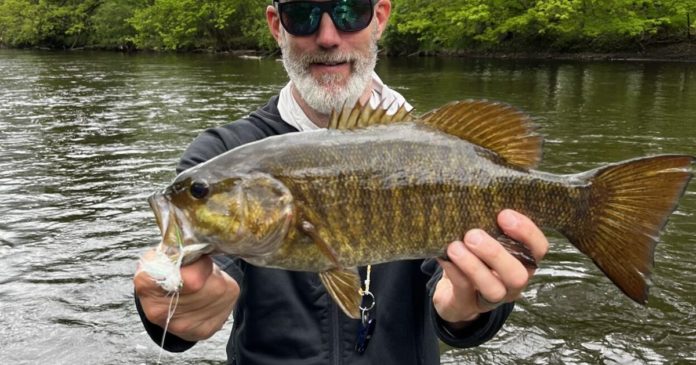Jon Osborn
July is the apex of summer, and that means afternoons at the beach, cookouts on the deck, and for sports fans, the cheer of the crowd and crack of the bat down at the ballpark.
Summer also means heat … a time when humidity settles over the Midwest like a wet wool blanket, leaving folks panting like Labradors in a lawn. As a kid, I remember plenty of sweaty July evenings spent in front of a window fan — and me longing for a swimming pool or one of those window air-conditioner units some of my wealthier friends enjoyed.
Seasonal swelter exacts a toll on anglers, as well. The glorious hand-over-fist fishing days of May and June are long gone. Come July, the rivers flow tepid, and trout — those speckled darlings of the fly-fishing community — can’t handle being handled. Even catch-and-release tactics won’t guarantee their survival, so conscientious sportsmen set their rods aside until cooler weather arrives.
Fortunately, the dog days don’t mean all the fishing fun is over. July is prime season for smallmouth bass, and these robust, acrobatic members of the sunfish family offer fine fly rod sport throughout the scorching summer months. Trout get plenty of press among fishermen, but smallmouths are the unsung heroes of the angling world. They hammer flies with unbridled aggression and fight like Colin MacGregor on a cocaine binge.
Tom Werkman is an Orvis-endorsed guide and a certified smallmouth fanatic. As co-owner of Werkman Outfitters, he guides clients along the Grand River and surrounding Kent County streams, where a day on the water might include casting flies or traditional tackle for salmon, steelhead, pike, or largemouth bass. And Tom isn’t bashful about his affinity for bronzebacks. We chatted recently and he agreed to share some of his hard-won wisdom:
“There are plenty of reasons to chase smallies on the fly,” Werkman began. “For one, you don’t need to travel far, because they’re native to the state and widely distributed throughout Michigan — even near crowded urban areas. Plus, bass are less affected by warm water and summer heat than trout.”
And if those weren’t sufficient motives, there’s Werkman’s favorite: “Smallmouth will cork a rod over like no other freshwater gamefish.”
Finding fish begins with an intimate knowledge of habits and habitat. Smallies favor moderate current most of the year, but their patterns and preferences change from season to season. In early spring, when water temperatures linger below 45 degrees, bass congregate in slower, deeper sections. Then, as rivers warm, they migrate away from those lazy comfort zones and seek out shallow, oxygen-rich riffles near rocky or woody cover.
“This behavior is completely temperature driven,” Werkman said. “Look for any deviance from the main flow near suitable cover and you’ll usually find fish.”
Like any species, hooking and landing smallmouths calls for specialized equipment. Nine-foot, eight-weight Orvis Recon rods are ideal because a stout setup helps bring bass to the boat quicker and stresses them less. Plus, a bit more backbone in the graphite makes casting waterlogged flies easier.
Orvis Hydros IV large-arbor reels retrieve line efficiently and minimize memory (coils).
And speaking of line, Werkman feels that the right fly line is vital to performance, and years of on-stream experience have vetted high-tech lines like Scientific Anglers Amplitude Bass Bug, Tropical Clear Intermediate, and Sonar Titan I 2/3 for bass.
Weather is key to smallmouth success. For Werkman, promising conditions include overcast skies and humid air in the mid-70s. A week of stable weather leading up to the event is optimal, and a slight breeze that imparts a bit of movement to the surface never hurts, either.
Soft, steady rain can also be beneficial because rising water washes forage into the river system. Invertebrates, like nightcrawlers and terrestrials, tumble from banks into the flow. What’s more, the amplified current flushes crayfish, hellgrammites, and baitfish into the mainstream. However, a heavy downpour tends to be counterproductive.
“All that added vibration interferes with the fish’s ability to sense prey in the water,” Werkman explained.
In a perfect world we’d always hit the river when conditions were textbook. However, unless you’re retired or living off a trust fund, you fish when responsibilities allow, regardless of the forecast. That means dealing with occasional east-winds and cold fronts – times when bass ignore flies, lures, and bait with equal disdain. What’s more, turbid water, a schizophrenic barometer, and an unstable forecast almost always put them off the feed. Anglers often bemoan cold fronts, but going the opposite direction, from extreme cold to very warm, gives bass a chronic case of lockjaw, Werkman added.
One of the endearing traits about smallmouth bass is their reputation for attacking anything that fits into their mouths, but crayfish and baitfish are preferred food sources in the cobbled streams where they live. To imitate mudbugs, Werkman opts for naturally colored tan or brown flies with some wiggle and shake. “Simplicity and durability are the name of the game,” he said. “I gravitate toward simple, single-hook patterns that incorporate rabbit strips and deer hair, like Fat Babies and Deviants.” Kevin Feenstra’s sculpin patterns are favorites as well.
July in Michigan means heat and humidity, but a day on the river offers a relief all its own. Baseball may be the all-American summer sport, but if you ask a guy like Werkman, fly fishing for smallmouth bass is the greatest game around.
Credit: Source link































